Guitar modes are an enchanting aspect of music theory that can unlock a wealth of creativity for guitarists. These are unique scales that you use to play lead guitar solos, compose music and create your unique guitar style. The seven guitar modes are: Ionian, Dorian, Phrygian, Lydian, Mixolydian, Aeolian, and Locrian — each offer a unique mood and flavor that can be tapped into for any piece of music.
Understanding guitar modes can truly elevate your playing, by offering new and different perspectives on scales.
It offers the much needed sophistication to beginners and the intrigue to the experienced. The modal structure breathes life into your musical journey, making you more than a guitarist but a musician, understanding the distinctive language of music.
As you delve into the world of modes, anticipating the sound of various scales becomes akin to a thrilling narrative unfolding. Each strum, each scale, unravels a new storyline, making you the narrator of your own musical saga!
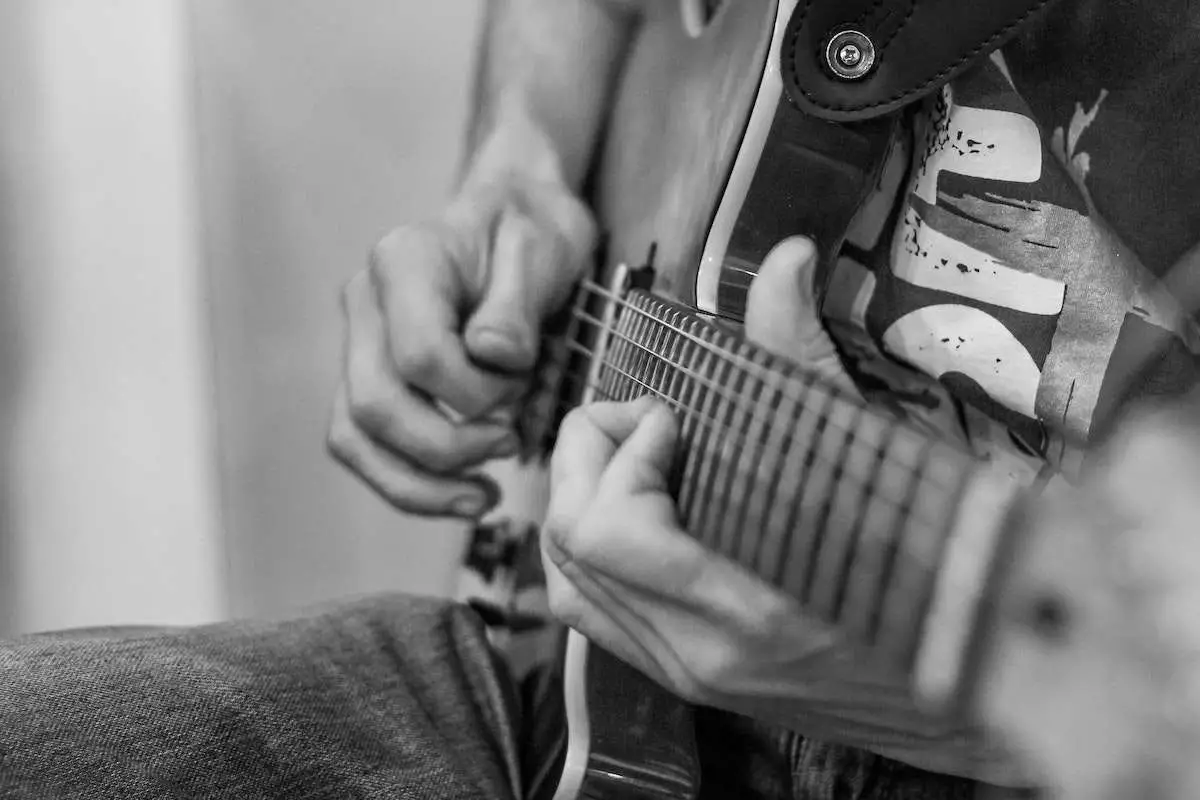
What Are Guitar Modes?
Guitar modes are an essential component of music theory that allow musicians to explore different tonalities and create unique melodies.
Understanding modes is crucial for guitarists looking to expand their musical vocabulary and add depth to their playing. To comprehend the concept of modes, it is necessary to have a solid grasp of scales, guitar chords, and the fundamentals of music theory.
Modes on guitar are essentially scales derived from the major scale. The major scale serves as a foundation for all the modes and consists of seven notes: Ionian, Dorian, Phrygian, Lydian, Mixolydian, Aeolian, and Locrian.
Each mode starts on a different scale degree while maintaining the same seven notes as the major scale. Let’s delve into each mode in more detail:
Ionian Mode:
The Ionian mode is otherwise known as the major scale itself. It is characterized by its bright and cheerful sound and forms the basis for many popular songs.
Comprising major triads built on each degree of the scale, this mode provides a solid foundation for understanding other modes.
Dorian Mode:
The Dorian mode is often associated with a minor sound due to its characteristic minor third interval between its first and third notes.
However, it retains a major sixth interval compared to a typical natural minor scale. This mode has an introspective quality frequently heard in jazz fusion and blues music.
Phrygian Mode:
With its distinctive Spanish flair, the Phrygian mode possesses a unique tonality characterized by its flattened second degree compared to both major and natural minor scales.
This gives it an exotic edge that can be found in various genres such as flamenco or progressive rock.
Lydian Mode:
The Lydian mode stands out due to its raised fourth scale degree compared to other common scales like Ionian or natural minor scales.
This alteration creates a dreamy and mysterious atmosphere that is often used in film soundtracks and progressive music.
Mixolydian Mode:
The Mixolydian mode is known for its dominant sound, as it features a minor seventh interval compared to the major scale. It is frequently utilized in blues, rock, and funk genres to create a bluesy feel or inject energy into chord progressions.
Aeolian Mode
The Aeolian mode, also known as the natural minor scale, is one of the seven musical modes.
It is derived from the major scale and features a pattern of whole and half steps, where the half steps occur between the 2nd and 3rd, and 5th and 6th degrees of the scale.
The Aeolian mode has a different tonal quality from its relative major, often described as melancholic or somber because of the introduction of a minor third.
Locrian Mode
The Locrian mode, the least commonly used in Western music, starts and finishes on the seventh degree of the diatonic scale.
This mode has a distinct sound, often described as unstable or tense due to the diminished fifth.
Overall, Modes provide a versatile palette of tonalities that can enhance your playing and composition skills. By mastering the different scale shapes associated with each mode on the guitar fretboard, you gain the ability to effortlessly navigate through various musical landscapes.
Understanding the theory behind each mode empowers you to choose the appropriate one when improvising over specific chord progressions or creating melodic hooks.
Exploring how each mode interacts with different chord qualities expands your musical options and allows for more expressive playing. With dedication and practice, guitarists can unlock the captivating world of modes and take your playing to new heights
Music Theory Behind Guitar Modes
In music theory, a mode is a type of musical scale, with guitar modes being variants of these scales that result in different tonal characteristics.
Music modes have roots in ancient music theory and are named after ancient Greek tribes: Ionian, Dorian, Phrygian, Lydian, Mixolydian, Aeolian, and Locrian.
Each mode starts and ends on a different note within the major scale, and this change of “tonal center”, or key, is what gives each mode its unique sound.
Understanding modes comes down to understanding intervals, or the distance between notes on the scale, as each mode’s unique series of intervals is what gives it its distinct sound.
For example, the Major scale (also known as the Ionian mode) follows a specific pattern of whole and half steps.
By changing the order of these steps, you create the different modes. So, learning to play in a specific mode means understanding and applying its particular pattern of intervals.
The Ionian Mode
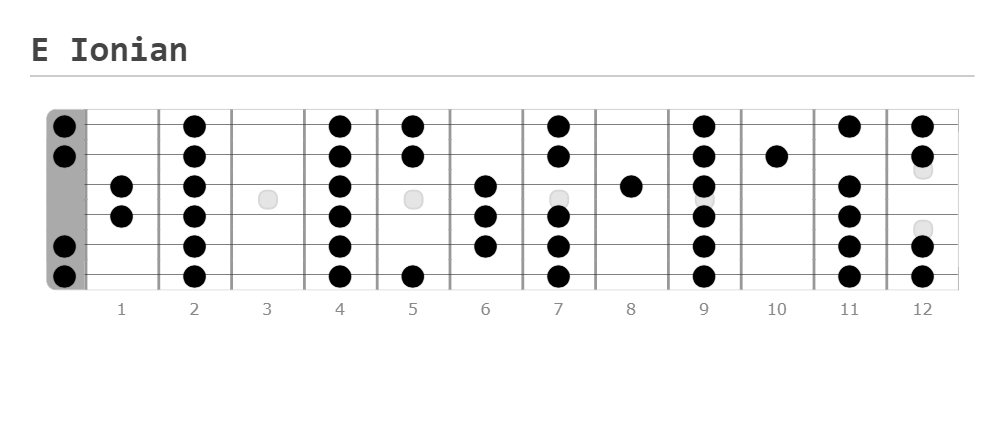
The Ionian mode, also known as the major scale, is first mode derived from the diatonic scale in the Western music theory.
It consists of seven pitches per octave, arranged in a pattern of whole and half steps. The Ionian mode starts on the first degree of the diatonic scale, and its specific pattern, consisting of two tetrachords separated by a whole step, is Whole-Whole-Half-Whole-Whole-Whole-Half.
The Ionian mode is often used in various musical genres due to its consonant and harmonically rich sound. It serves as the foundation for many melodies, chord progressions, and harmonies. A tune written in Ionian mode often carries a happy and joyful mood due to its major quality.
The Dorian Mode
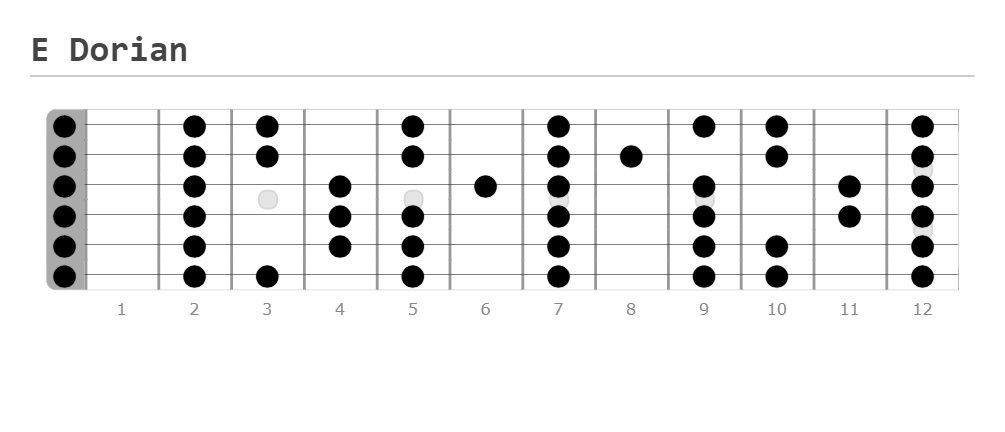
The Dorian mode is one of the seven diatonic modes and the second mode of the diatonic scale.
It starts from the second degree of the major scale, so for a D Dorian mode, it would start on a D note in the C major scale, including all the white keys from D to D.
The specific pattern is a step-wise sequence of whole-half-whole-whole-whole-half-whole, which distinguishes it from the major (or Ionian) and minor (or Aeolian) scales.
Musically, the Dorian mode creates a jazz or bluesy feeling, due to its minor tonality and raised sixth.
While it shares the same notes as its relative major scale, by centering the tonality around the D (in the case of D Dorian), the respective minor keys and chords become more prominent, generally adding a melancholy or contemplative tone to the music.
The Phrygian Mode
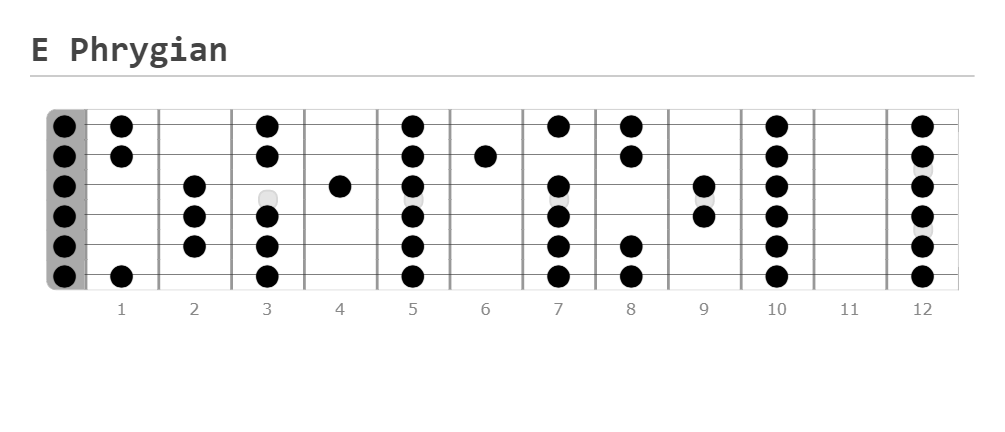
The Phrygian mode is a seven-note musical scale found in traditional and contemporary music.
Because it is built from the third note of the major scale, a Phrygian scale contains the same notes as the major scale two steps above it—for instance, an E Phrygian scale is rooted in the same notes as a C Major scale.
In terms of interval sequence, a Phrygian scale follows the pattern: half step, whole step, whole step, whole step, half step, whole step, whole step.
This places the characteristic “minor second” at the beginning, which gives music in the Phrygian mode a distinctive “Eastern” sound. To illustrate, a C Phrygian scale would include: C, Db, Eb, F, G, Ab, and Bb.
The Lydian Mode
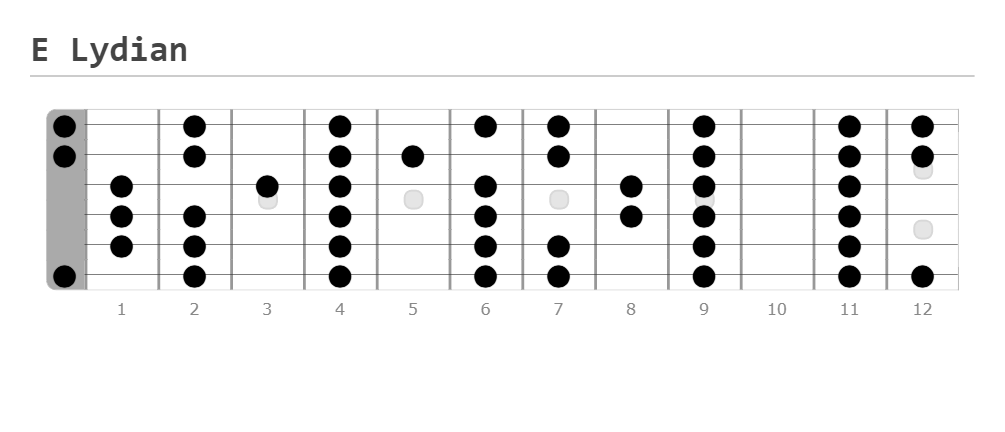
Lydian is the fourth mode & is derived from the major scale and thus it consists of the same pitches as the major scale, but with a distinctive raised fourth.
That is, if G is the root of the Lydian mode, the major scale would shift the note B natural in the G major scale to B flat in the G Lydian mode.
So in terms of order from tonic to octave, the arrangement is: Whole, Whole, Whole, Half, Whole, Whole, Half.
This distinction gives the Lydian mode a somewhat unsettled, otherworldly sound. The raise fourth note disrupts the more usually balancing Perfect Fifth relationship found in the major scale or Ionian mode, producing an unfamiliar tension. This makes Lydian suitably fitted for creating mood changes in music composition when weaving between different modes.
With that said, while its uniqueness may be more hidden compared other modes like major or minor scales, the Lydian mode indeed has its function and distinctive color that can enrich musical expression.
The Mixolydian Mode
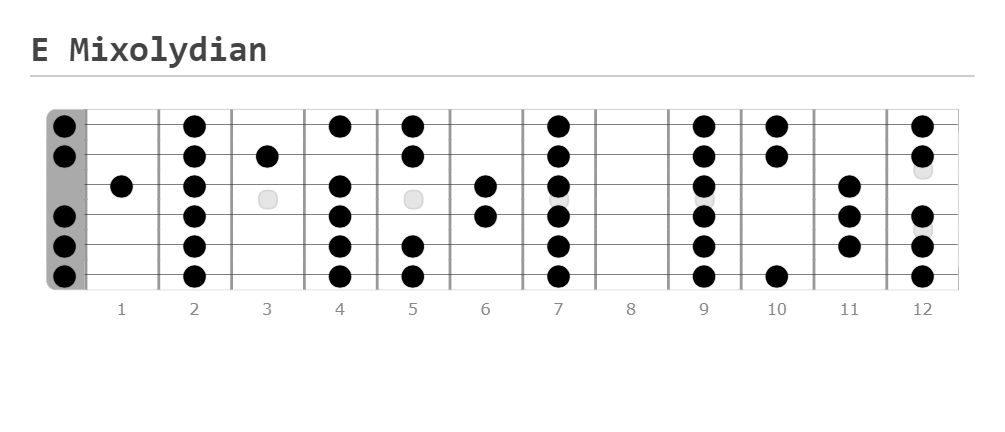
Belonging to the family of seven diatonic modes or scales in Western music, the ‘Mixolydian’ mode, notably, is focused on the fifth degree or dominant of the diatonic scale.
Its formation originates on the fifth note of a major scale. For instance, a G Mixolydian mode will comprise the same notes as the C Major scale but will start on note G instead of C.
Structurally, the Mixolydian scale has its major-mode character but includes a minor 7th giving it a ‘major-minor’ ambivalent quality.
The pattern follows the sequence Whole, Whole, Half, Whole, Whole, Half, Whole. For instance, for G Mixolydian, the resulting notes would be G, A, B, C, D, E and F.
In addition to the mentioned peculiarity, this mode is also known to give bluesy or ‘funky’ vibe and finds utility in jazz, pop, rock and electronic music genres among others.
The Aeolian Mode
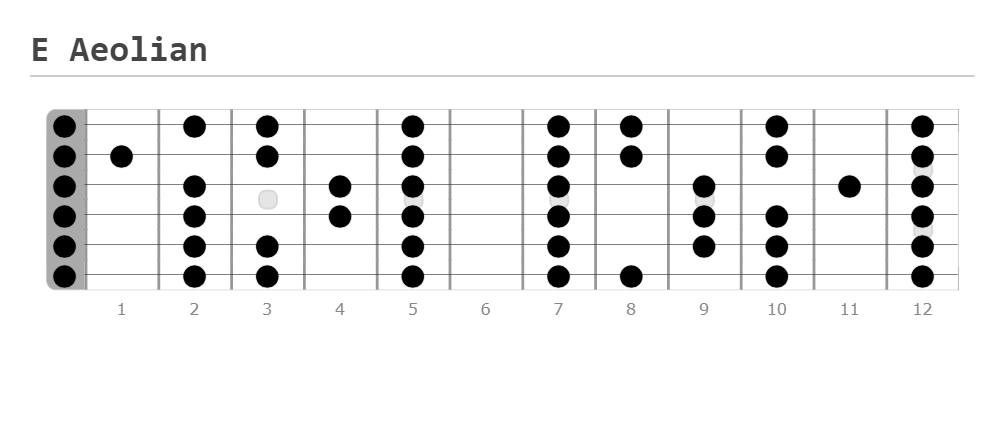
The Aeolian mode is also known as the natural minor scale. In the framework of the natural minor scale, the Aeolian mode is always set from the first scale degree to the first again; for instance, an A Aeolian scale’s notes arе arranged as A-B-C-D-E-F-G. If translated into the distinctive arrangement of half steps and whole steps, it follows the pattern: whole-half-whole-whole-half-whole-whole.
In music theory, the Aeolian mode is widely associated with a somber and melancholic mood due to its minor characteristic.
Due to its tonal property which allows for an effective conveyance of sad feelings, this modе is extensively used in several genres of music, ranging from classical to rock.
Mastering the Aeolian mode not only provides musicians the freedom to transmit deeper emotion in their music but also assists them in understanding relative music theory concepts.
The Locrian Mode
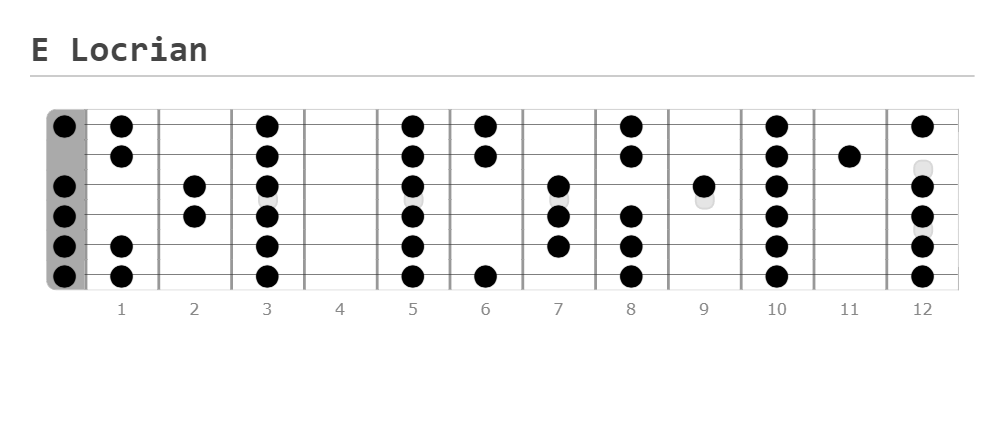
The Locrian mode is the last of the modes in music theory, characterized by the unique pattern: Half-Whole-Whole-Half-Whole-Whole-Whole.
This pattern is produced by starting and ending a sequence from the seventh note of a conventional major scale. For example, to achieve the B Locrian mode, one would play all natural notes on the scale from B to B.
Additionally, the Locrian mode is perceived as the least frequently used among music modes owing to its ‘unstable’ tonal center.
This phenomenon is primarily due to the flatted fifth degree—also known as a ‘tritone’ or ‘diminished fifth’—in this music mode.
Such a characteristic contributes to the absence of a perfect fifth degree, making Locrian sound naturally ‘tension-filled’ and somewhat ambiguous.
Regardless of its uncommonness, the understanding and proficiency in the Locrian mode are beneficial skills reckoned instrumental within musicians and composers’ toolkits, particularly when intending to create tense, unsettling moments in a musical piece, or contributing in diverse genres as jazz, fusion and progressive rock.
Moreover, conscious modifications can herald peculiar chord combinations, seemingly clumsy at first instant but valuable insights from the standards of diverse harmony enhancements.

Major Modes vs Minor Modes
Of the seven guitar modes, two essential ones are the Major Mode ( Ionian) and the Minor Mode (Aeolian).
A mode is major if the third degree is a major third above the root note, else it is considered minor.
Consider the G Major Mode scale, also known as the Ionian mode, the notes will be as following: G, A, B, C, D, E, F#.
Immediately you would notice that it consists of seven different notes including a major third (B), culminating with a note (F# ) that leads back to the root.
Similarly, the A minor mode, or the Aeolian mode, presents a characteristic dark, melancholic feel. The corresponding scale would read as A, B, C, D, E, F, G—of seven different notes while A-Minor’s third interval yields the key to unlock the minor tonality.
Sound-wise, major modes are often perceived as bright and cheerful, presenting a consonance feeling associated with resolve, completion and totality—a leading mood setter inherent to a higher number of happy, uplifting, love songs.
On the other hand, the minor modes generally convey a round of mixed feelings of sadness, somberness and seriousness associated with confusing ambivalent unsettling unsettling
How To Memorize The Modes
Memorizing guitar modes is best accomplished through a combination of understanding the theoretical basis of each mode, consistent practice, and utilization of mnemonics or patterns.
Firstly, comprehend that every mode is a derivative of the major scale, starting from a different degree. For example, the D Dorian mode starts from the second degree of the C major scale.
Secondly, practice these modes consistently, ideally with a backing track. This helps to understand how they sound over different chords. Regular, slow practice on the guitar neck can ensure a thorough grasp and technical command.
Thirdly, try to visualize patterns or shapes on the fretboard for each mode, this will encourage a quicker recall. Also, knowing which mode fits over which chord can help too. It’s crucial to learn the distinct sound and mood each mode creates as this will guide you on when and where to use them effectively. Finally, relate these modes to familiar songs. This can be an effective tool for cementing the sound and application of each mode in your mind.

Tips For Implementing Guitar Modes
Implementing guitar modes involves understanding the structure of each mode, learning how to play them on the guitar, and applying them in various musical contexts. Here are some steps to help you out in this area:
Learn the intervals and patterns: Understand the structure of each mode and the intervals that create its unique sound. Learn the fingerings and patterns for each mode on the guitar fretboard. Start with the natural minor scale (Aeolian mode) as it serves as the foundation for the other modes.
Practice scales and arpeggios: Practice each mode as a scale and as an arpeggio. Scales help you become familiar with the mode’s sound and how it fits on the guitar neck. Arpeggios allow you to emphasize the individual chord tones of each mode, making it easier to use them over corresponding chords.
Play along with backing tracks: Find backing tracks that are specifically designed for practicing modes. Play the modes over the appropriate chords to hear how they sound in context and develop your sense of phrasing.
Experiment with different chords: Try using the modes over various chords to hear how they interact and create different moods. For example, you can use the Dorian mode over a minor chord, or the Mixolydian mode over a dominant seventh chord.
Transcribe and analyze solos: Listen to guitarists who frequently use modes in their playing. Transcribe their solos to understand how they incorporate modes into their music. Analyze the phrases they use and how they connect different modes over chords.
Improvise using modes: Once you have a good understanding of the modes, start incorporating them into your improvisation. Experiment with using different modes over various chord progressions and explore how they sound in different musical genres.
Practice in all keys: Practice each mode in all 12 keys. This will enhance your ability to transpose and apply the modes to any musical situation.
Use backing tracks and jam with others: Utilize backing tracks and play with other musicians to apply your mode knowledge in real musical scenarios. Jamming with others helps you adapt and respond to different chord progressions and musical ideas.
Be patient and persistent: Learning to implement modes on the guitar takes time and practice. Be patient with yourself and keep practicing regularly to develop proficiency.
Remember that modes are just tools, and using them effectively comes with understanding their sound, practicing, and applying them in musical contexts. As you become more comfortable with modes, you’ll be able to add a unique flavor to your guitar playing and expand your musical palette.
Frequently Asked Questions
Should I learn modes on guitar?
Yes, absolutely! Learning guitar modes is crucial for exploring the vast world of music beyond Major and Minor scales.
This exposes you to various sounds and melodic possibilities, enabling more expressive solos and a broader understanding of scales and chords’ relationships.
Learning modes can be challenging, but it offers musical freedom and creativity, elevating your guitar playing to new levels.
What are the 7 modes of the minor scale?
The seven modes of a minor scale, which are also the modes of the major scale, are named after ancient Greek tribes. In order, these modes are:
1. Aeolian: Also known as the natural minor scale, Aeolian begins on the 6th degree of the major scale. It has a melancholic sound.
2. Locrian: This mode begins on the 7th degree of the major scale. It has a dissonant, unstable sound due to the flat 5th.
3. Ionian: Otherwise known as the major scale, Ionian begins on the 1st degree of the modern relative major. It sounds bright and happy.
4. Dorian: This mode begins on the 2nd degree of the major scale and is often used in jazz and blues music.
5. Phrygian: Beginning on the 3rd degree of the major scale, the Phrygian mode is commonly used in flamenco music.
6. Lydian: This mode starts on the 4th degree of the major scale and has a dreamy, somewhat surreal sound.
7. Mixolydian: Begging on the 5th degree of the major scale, the Mixolydian mode is popular in rock music.
What is the difference between major scales and modes?
Major scales and modes share the same set of notes but differ in their starting points and tonal centers.
A major scale follows a specific pattern of whole and half steps, creating a distinct sound characterized by its bright and uplifting quality.
Modes, on the other hand, use the same set of notes but start on different degrees of the major scale, resulting in various tonalities such as Dorian, Phrygian, Mixolydian, etc., each with its own unique mood and flavor.
While major scales maintain a consistent tonal center, modes offer different modal centers, lending diverse emotional and harmonic contexts to musical compositions.
Which guitar mode to learn first?
We suggest you begin your journey into guitar modes by learning the major scale aka the Ionian mode.
This foundation provides a solid understanding of the fundamental intervals and shapes, setting the stage for comprehending more complex modes.
Once you’re comfortable with the major scale and its patterns, transitioning to the natural minor scale aka the Aeolian mode becomes smoother, as the minor scale builds upon the major scale’s structure.
This sequential approach allows you to grasp the essential concepts progressively and facilitates your exploration of other modes too!
Are modes the same as keys?
Guitar keys and modes are related but not the same thing.
A key is the tonal center or main note that revolves around a piece of music, dictating the chord progressions and overall harmony.
Modes, on the other hand, are scales that use the same set of notes as a parent scale, typically a major or natural minor scale, but with a different starting point.
A key provides a more general harmonic context, whereas modes provide specific tonal colors and emotions.
Conclusion
Gaining an understanding of guitar modes can be a transformative experience for guitarists.
By delving into music theory and exploring various modes, a wide range of expressive possibilities becomes available.
The seven modes we covered where: Ionian, Dorian, Phrygian, Lydian, Mixolydian, Aeolian, and Locrian – each with its distinct characteristics.
Incorporating these modes into playing enhances comprehension of scale-chord relationships, leading to more intricate chord progressions beyond the limitations of major and minor keys.
Utilizing different scale shapes within each mode can infuse solos with fresh melodic ideas.
For example, in the key of C major, substituting a G major chord with a G7 chord from the mixolydian mode adds tension and resolves effectively to C major.
Exploring modes also enables the blending of different tonalities within a single piece of music.
For instance, combining chords from the Ionian mode (major) with chords from the Phrygian mode (minor) creates captivating contrasts that evoke diverse emotions.
Incorporating modes in musical vocabulary liberates players from predictable patterns and traditional tonalities. Expanding beyond playing solely in a single major or minor mode throughout a song or solo section leads to the creation of captivating musical landscapes.
Throughout this journey, it’s revealed that while all modes share the same seven notes, each possesses a unique personality. Integrating major and minor chords within these modes results in harmonically rich compositions that deeply engage listeners.
To embark on this journey, the text encourages picking up the guitar, immersing oneself in the world of guitar modes, and allowing creativity to soar without limits.
